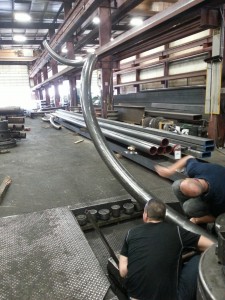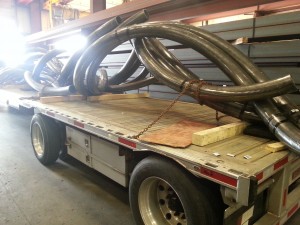Many companies are finding new uses for the helical bending of steel pipe or tubes. Pipe and tubing can be extremely functional in applications which need a helical curve, though rolling pipe helically presents several challenges. Perhaps the most common example used in helical pipe jobs is when a designer calls for handrails on curved staircases. Very common in handrail jobs, bender/rollers will see call outs for 1 ½” schedule 40 pipe, or something very similar in size.
Now, the initial challenge for rolling pipe in a helical fashion is the difference between the plan view dimension radius, and what would be the actual helical radius. If you were to use the plan view, or ‘top-down’, radius and roll the handrails to those dimensions, you would most likely be left with a piece of material that is well out of tolerance for the project. The level radius, and pitched radius can vary a great deal when compared to each other. Essentially, the pitched radius is running diagonally over a longer distance, increasing the radius. Unless you are correctly including the pitch into the rolling calculations, your end results will not match up with the expectations for your customer.
In some cases, a ‘close-enough’ radius might work for a handrail over a shorter distance. If the radius is large enough, a level radius can be calculated which is functional. But other projects require a greater understanding of how to roll material in a true, helical manner. In these situations, a skilled operator can make the necessary adjustments to keep the pipe rolled on a consistent radius. Even in situations where the pipe size is large or the radius is very tight. One such recent example was involved a project of 6” pipe rolled helically to several different radial dimensions less than 36 inches, with varying pitch. Production staff would need to verify the dimensions of rolling consistently to ensure these stayed as close as possible.

Even once all material is rolled and completed, there can still remain one often overlooked challenge involved in helical pipe bending. The necessities for shipping helical pipe require some forethought due to the awkward dimensions. Helical pipe won’t always bundle as nicely as an item rolled flat and level. For this reason, helical rolling of structural shapes often involves scheduling shipping via flatbed versus loading into common carrier shipments. Unless the items are small enough to be boxed and placed on pallets, the items will often not store properly in the back of standard box trucks.








